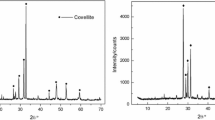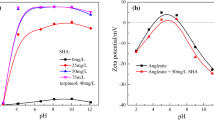Abstract
Evaluation of flotation behavior, solution measurements, and surface analyses were performed to investigate the effects of chloride ion addition on the sulfidization of cerussite in this study. Micro-flotation tests indicate that the addition of chloride ions prior to sulfidization can significantly increase the flotation recovery of cerussite, which is attributed to the formation of more lead sulfide species on the mineral surface. Solution measurement results suggest that the addition of chloride ions prior to sulfidization induces the transformation of more sulfide ions from pulp solution onto the mineral surface by the formation of more lead sulfide species. X-ray diffraction and energy-dispersive spectroscopy indicate that more lead sulfide species form on the mineral surface when chloride ions are added prior to sulfidization. These results demonstrate that the addition of chloride ions prior to sulfidization can significantly improve the sulfidization of cerussite, thereby enhancing the flotation performance.
Similar content being viewed by others
References
Q.C. Feng, S.M. Wen, Y.J. Wang, W.J. Zhao, and J.S. Deng, Investigation of leaching kinetics of cerussite in sodium hydroxide solutions, Physicochem. Probl. Miner. Process., 51(2015), No. 2, p. 491.
Q.C. Feng, S.M. Wen, Y.J. Wang, W.J. Zhao, and J. Liu, Dissolution kinetics of cerussite in acidic sodium chloride solutions, Bull. Korean Chem. Soc., 36(2015), No. 4, p. 1100.
K.Q. Fa, J.D. Miller, T. Jiang, and G.H. Li, Sulphidization flotation for recovery of lead and zinc from oxide–sulfide ores, Trans. Nonferrous Met. Soc. China, 15(2005), No. 5, p. 1138.
G. Önal, G. Bulut, A. Gül, O. Kangal, K.T. Perek, and F. Arslan, Flotation of Aladag oxide lead–zinc ores, Miner. Eng., 18(2005), No. 2, p. 279.
S. Moradi and A.J. Monhemius, Mixed sulphide–oxide lead and zinc ores: problems and solutions, Miner. Eng., 24(2011), No. 10, p. 1062.
M.C. Fuerstenau, S.A. Olivas, R. Herrera-Urbina, and K.N. Han, The surface characteristics and flotation behavior of ananglesite and cerussite, Int. J. Miner. Process., 20(1987), No. 1-2, p. 73.
R. Herrera-Urbina, F.J. Sotillo, and D.W. Fuerstenau, Effect of sodium sulfide additions on the pulp potential and amyl xanthate flotation of cerussite and galena, Int. J. Miner. Process., 55(1999), No. 3, p. 157.
S.R. Popov and D.R. Vucinic, Adsorption characteristics and floatability of cerussite with ethylxanthate in the presence of dissolved lead ion, Int. J. Miner. Process., 34(1992), No. 4, p. 307.
S.R. Popov and D.R. Vucinic, The effect of prolonged agitation in lead ion solution on ethylxanthate adsorption and surface characteristics of cerussite, Int. J. Miner. Process., 35(1992), No. 1-2, p. 85.
S.R. Popov and D.R. Vucinic, Kinetics of ethylxanthate adsorption on cerussite in alkaline media in presence or absence of dissolved lead ions, Int. J. Miner. Process., 41(1994), No. 1-2, p. 115.
C. Cozza, V.D. Castro, G. Polzonetti, and A.M. Marabini, An X-ray photoelectron spectroscopy (XPS) study of the interaction of mercapto-benzo-thiazole with cerussite, Int. J. Miner. Process., 34(1992), No. 1-2, p. 23.
Y.K. Zhu, C.Y. Sun, and W.G. Wu, A new synthetic chelating collector for the flotation of oxidized-lead mineral, J. Univ. Sci. Technol. Beijing, 14(2007), No. 1, p. 9.
R. Herrera-Urbina, F.J. Sotillo, and D.W. Fuerstenau, Amyl xanthate uptake by natural and sulfide-treated cerussite and galena, Int. J. Miner. Process., 55(1998), No. 2, p. 113.
A.N. Buckley and R. Woods, Xanthate chemisorption on lead sulfide, Colloids Surf. A., 89(1994), No. 1, p. 71.
J. Ralston, The chemistry of galena flotation: principles and practice, Miner. Eng., 7(1994), No. 5-6, p. 715.
D. Lascelles and J.A. Finch, A technique for quantification of adsorbed collectors: xanthate, Miner. Eng., 18(2005), No. 2, p. 257.
P. Huang, L. Wang, and Q. Liu, Depressant function of high molecular weight polyacrylamide in the xanthate flotation of chalcopyrite and galena, Int. J. Miner. Process., 128(2014), p. 6.
B. Wang and Y.J. Peng, The behaviour of mineral matter in fine coal flotation using saline water, Fuel, 109(2013), p. 309.
L.G. Wang, Modeling of bubble coalescence in saline water in the presence of flotation frothers, Int. J. Miner. Process., 134(2015), p. 41.
M. Zhang, Y.J. Peng, and N. Xu, The effect of sea water on copper and gold flotation in the presence of bentonite, Miner. Eng., 77(2015), p. 93.
M.A. Hampton and A.V. Nguyen, Accumulation of dissolved gases at hydrophobic surfaces in water and sodium chloride solutions: Implications for coal flotation, Miner. Eng., 22(2009), No. 9-10, p. 786.
O. Ramos, S. Castro, and J.S. Laskowski, Copper–molybdenum ores flotation in sea water: Floatability and frothability, Miner. Eng., 53(2013), p. 108.
B. Wang and Y.J. Peng, The effect of saline water on mineral flotation: a critical review, Miner. Eng., 66-68(2014), p. 13.
J.R. Bargar, G.E. Brown, and G.A. Parks, Surface complexation of Pb(II) at oxide–water interfaces: III. XAFS determination of Pb(II) and Pb(II)–chloro adsorption complexes on goethite and alumina, Geochim. Cosmochim. Acta, 62(1998), No. 2, p. 193.
Y.B. Guo, C. Li, Y.C. Liu, L.M. Yu, Z.Q. Ma, C.X. Liu, and H.J. Li, Effect of microstructure variation on the corrosion behavior of high-strength low-alloy steel in 3.5wt% NaCl solution, Int. J. Miner. Metall. Mater., 22(2015), No. 6, p. 604.
A. Wierzbicka-Miernik, J. Guspiel, and L. Zabdyr, Corrosion behavior of lead-free SAC-type solder alloys in liquid media, Arch. Civ. Mech. Eng., 15(2015), No. 1, p. 206.
J.D. Hem, Geochemical controls on lead concentrations in stream water and sediments, Geochim. Cosmochim. Acta, 40(1976), No. 6, p. 599.
A.W. Mann and R.L. Deutscher, Solution geochemistry of lead and zinc in water containing carbonate, sulphate and chloride ions, Chem. Geol., 29(1980), No. 1-4, p. 293.
K.J. Powell, P.L. Brown, R.H. Byrne, T. Gajda, G. Hefter, A.K. Leuz, S. Sjöberg, and H. Wanner, Chemical speciation of environmentally significant metals with inorganic ligands: Part 3. The Pb2+ + OH–, Cl–, CO 2-3 , SO 2-4 , and PO 3-4 systems (IUPAC technical report), Pure Appl. Chem., 81(2009), No. 12, p. 2425.
Y.Y. Wang, L.Y. Chai, H. Chang, X.Y. Peng, and Y.D. Shu, Equilibrium of hydroxyl complex ions in Pb2+–H2O system, Trans. Nonferrous Met. Soc. China, 19(2009), No. 2, p. 458.
M.C. Fuerstenau, C.C. Chen, K.N. Han, and B.R. Palmer, Kinetics of galena dissolution in ferric chloride solutions, Metall. Trans. B, 17(1986), No. 3, p. 415.
G. Senanayake and D.M. Muir, Speciation and reduction potentials of metal ions in concentrated chloride and sulfate solutions relevant to processing base metal sulfides, Metall. Trans. B, 19(1988), No. 1, p. 37.
D.W. Fuerstenau, J.M. Rosenbaum, and J. Laskowski, Effect of surface functional groups on the flotation of coal, Colloids Surf., 8(1983), No. 2, p. 153.
B.J. Arnold and F.F. Aplan, The effect of clay slimes on coal flotation: Part II. The role of water quality, Int. J. Miner. Process., 17(1986), No. 3-4, p. 243.
M. Hancer, M.S. Celik, and J.D. Miller, The significance of interfacial water structure in soluble salt flotation systems, J. Colloid Interface Sci., 235(2001), No. 1, p. 150.
Author information
Authors and Affiliations
Corresponding author
Rights and permissions
About this article
Cite this article
Feng, Qc., Wen, Sm., Zhao, Wj. et al. A novel method for improving cerussite sulfidization. Int J Miner Metall Mater 23, 609–617 (2016). https://doi.org/10.1007/s12613-016-1273-5
Received:
Revised:
Accepted:
Published:
Issue Date:
DOI: https://doi.org/10.1007/s12613-016-1273-5




